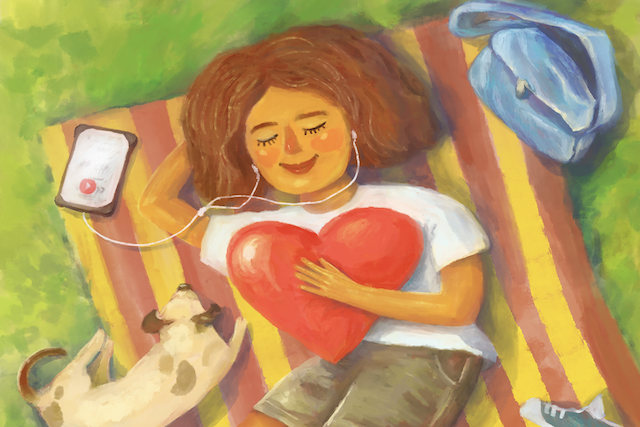[ad_1]

“Be a curator of your life. Slowly cut things out until you’re left only with what you love, with what’s necessary, with what makes you happy.” ~Leo Babauta
As a kid, I remember begging my dad to take me to Burger King, Wendy’s, McDonalds, and any other number of fast food restaurants. Their food was okay, but that’s not the main reason I went. The toys were what beckoned me.
Each chain offered different ones, some of which interested me more than others. The Mini Nintendos at Taco Bell? I was there. Assemble your own Inspector Gadget at McDonalds? Count me in on that Happy Meal.
I remember gleefully jotting my Christmas lists inside the Grinch who Stole Christmas ornament-shaped notepad I’d extracted from beneath a soggy container of fries at the bottom of my Wendy’s kids’ meal bag.
When Burger King came out with Pokemon toys, I raced on over. My goal was to get enough Poke balls to strap to every belt loop—because people in class, pedestrians sharing the street with me, and my family at home all needed to know how serious, esteemed, and accomplished of a Pokemon trainer I was.
Meanwhile, the neglected burger and the remainder of fries glistened untouched beneath the fluorescent lights, off to the side.
Ever since I was little, surplus brought me comfort.
An all-in kind of girl when it came to my belongings and collections, I threw myself into the hobby of collecting and amassing—everything from Archie comics to souvenir pennies to Pepsi cans featuring photos of different Star Wars characters (which my mom hated and my cat enjoyed swatting around, only to be startled by the noise whenever they crashed against the ground).
My room contained surplus—whether that was after a trip to the library with my mom, or from Beanie Babies scattering the floor. Bobbleheads crowded my shelves. Shot glasses that I used as cups for my dolls and stuffed animals during our play tea parties did as well.
So did the pages of my angsty adolescent diary. One poster of Aaron Carter or a single pin-up of J.T.T. didn’t cut it for me—I had to fill the entire wall. How I managed to not feel unsettled falling asleep under the watch of so many prepubescent boy eyes still mystifies me.
Material surplus as a child became surplus of a more abstract kind as a young adult. People, experiences, a large social circle, and nonstop activities took the place of physical objects. These grown-up versions of childhood collections served the same function my clutter once did.
I scheduled back-to-back activities, unnerved by the thought of banking on solely one interaction to sustain me though the day. My schedule was constantly full.
Where Does the Drive for More Come From?
Reasons for “hoarding mentality” are numerous. I can see looking back now how surplus brought me comfort as a kid. Material excess likely allayed feelings of solitude.
At one point I even wrote in my journal: “I believe many of us collect to fill voids. More means never going without, never living in scarcity. More confers safety. More means escaping alone-ness. If I just keep accumulating more more more, maybe at some point I can let out all this breath I’ve been holding in.”
Our cultural climate likely also contributed. It capitalizes upon low self-worth and generalized ennui to sell the message that solutions and relief lie in consumption—consume more to fill the emptiness, may as well be their mantra.
Additionally, I believe we create surplus when we don’t trust. We don’t trust what we have is enough. Or we don’t trust it’s good enough.
I think about all the unfinished drafts on my computer over the years. Littering the pages were paragraphs of clumsy prose and scattered ideas, all chucked into the document and then abandoned.
One paragraph on racial inequality. Introduction, scattered thoughts… abandoned.
Two paragraphs of a fiction piece on a one-night stand. Introduction, rising action… abandoned.
I didn’t trust the voice. I didn’t trust the content. I didn’t trust the direction the piece was going in. I didn’t trust anything about it—so abandoning it felt like the comfortable, somewhat logical option.
After fleeing it and attempting to start anew, I didn’t trust in the voice of this draft either, so I fled that one as well. Abandonment seemed the common trend, syntactically if not thematically. And over time all these abandonments, fueled by lack of trust, left surplus in its wake.
I once compared the scatter-focused to the hyper-focused work style: More cups for the scatter-focused worker means less likelihood of failure—because if one’s not working, they can always shift focus to another. A half-finished project isn’t a failure. It just hasn’t been completed yet.
Or think of it as putting your eggs into different baskets. You don’t want to put too much pressure on any one friend; instead, you spread your efforts onto multiple so that no one gets overwhelmed.
It’s similar to the way some scatter-focused workers might view tasks. Dividing our attention amongst various simultaneous assignments takes pressure off any single one of them, reducing the likelihood of “botching it.” Because if one’s not working, they can always shift attention to another.
Some of us who allow surplus into our lives may have difficulty with letting go.
I grow attached to the things I write, for instance, even if I know they’re bad. A weak sentence, or a paragraph wherein the phrases are all jumbled together and not working in unison—even as this clunky tangle of words on the screen makes my head spin, I still fear hitting that delete button and watching my ideas vanish completely.
I fear hitting it because even in their imperfect expression, they were still my ideas, born in a moment of generativity. I was adding something to the world, however small and insignificant, when I spawned them.
Is Surplus Bad?
I’m not trying to say that surplus is inherently bad; many people not only can successfully juggle multiple commitments, but likely even have to in order to stay afloat in this increasingly demanding world.
What I am saying is that sometimes the hoarding mentality can prevent us from mindfully attending to what’s directly in front of us.
As I came to find through my own later life experiences, “‘more” can sometimes feed disconnection.
I once drove a Lyft passenger who, together with his wife, fostered twenty-two cats—a number he said was a “manageable amount.” He said that he didn’t think he could take in any more.
“It’s very hard, because we want to say yes to all of them,” Jacob said, “But we’ve also got to think about how many we can realistically care for.”
He then quipped, “Crazy cat ladies get a bad rap because they’re too idealistic. They’re in over their heads even, is what I’d say. She’s crossed the threshold from cat lover to cat addict.”
We talked about the point at which a loving impulse turns into an addiction. About how even if the addicted person started out loving the thing they’re now addicted to, once compulsion has replaced it, love may no longer be at the center of the equation anymore.
Jacob’s saying that he “wouldn’t be able to love fifty-six cats” resonated with me. I recalled how back when I had only one or two Pez dispensers, I really treasured them. They meant more to me. We had as close to an intimate connection as is possible for a human and a chunk of plastic to have with one another.
The more my supply multiplied though, the less connection I felt with any single one of them.
Looking back now, I’m just glad those Pez were inanimate objects rather than living creatures with needs and pain receptors—because they surely would have felt the sting of negligence under my care.
~~
Becoming more aware of the roots of these tendencies has helped me to gradually shift them.
The past few years I’ve slowly and steadily fengshui-ed many of the items accumulated throughout my past. The Pez dispensers were the first to go—to a customer through eBay.
Next it was 1,050 of my 1,075 Archie comics (I kept a few as souvenirs from childhood, for nostalgic purposes). Writing I’d always found too difficult to part with, I’ve slowly recycled as well (after salvaging whichever remnants I saw some potential value in).
I’ve sought more one-on-one interactions, careful to not plan too many in too short a period of time—both to preserve my energy and give each encounter the attention I feel it deserves.
As minimalist Youtuber Ronald Banks said, “Minimalism is living with more of what matters by choosing to want less of what doesn’t.”
When I do find myself starting to accumulate—be that material items or events on my social calendar— I ask myself questions now. Questions like, Am I saying yes to have one more item to add to my stash? Or because I genuinely connect and derive meaning from it?
Are my motives extrinsic and escapist—tied more to bolstering my image or avoiding an uncomfortable emotion? Or are they intrinsic and self-actualizing—aimed toward the purpose of connecting?
I wouldn’t say I’m a minimalist now, but I have become a bit more intentionally resistant toward what I now regard as the false comfort brought by surplus. I realize now I don’t need more things, more friends, more projects, more commitments. I just need to recognize when I’m trying to fill a void and instead focus more on the things I value most.
About Eleni Stephanides
A queer bilingual writer, Eleni was born and raised in the Bay Area. She has been writing since elementary school, where she handed out her stories and magazines to her classmates. Her work has been published in The Mighty, Thought Catalogue, Elephant Journal, and Uncomfortable Revolution. You can follow her on IG eleni_steph_writer and read stories from her time as a rideshare driver at lyfttales.com.
[ad_2]
tinybuddha.com







